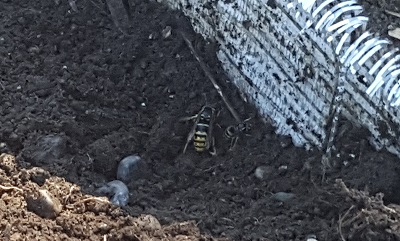I was not ready for a garden this season. My life is in a state of transition and I am without gardening space of my own. In spite of that, when some generous friends offered up the use of a lovely, but long neglected, overgrown raised bed near where I live, the longing to work the soil and grow things to feed my small family overrode my uncertainty. In early June–late to start weeding and prepping garden space even by Alaska standards–I began.
After a busy weekend of pulling weeds and prepping soil, I returned to my raised bed to plant seeds and transplant some root-bound starts I found for 50 cents at Alaska Mill and Feed. Not long into my planting endeavor, I noticed a bunch of bees flying around me. I stepped back, watched for a while, and observed them coming and going from a small space within my garden, between the soil edge and the wooden frame of the raised bed. This was only three days after I had pulled dense, intertwined root mats and turned fresh, beautiful soil in this very place! But alas, some sort of insect resembling a bee or a wasp had clearly taken residence. I love bees–I told myself. They are pollinators and are a critical part of the ecosystem. But do I really want them in my garden? How am I going to deal with this? I don’t want to risk getting stung every time I go to weed or harvest veggies.

Bees or Wasps?
My newfound insect population inspired me to do some research.
My initial fear was that these insects were yellowjackets, which I have since learned are actually a wasp, not a bee. Yellowjackets are found in Alaska and many other parts of the US, can be quite aggressive if their nest is disturbed, have a nasty sting and a single wasp can sting multiple times. I was not very excited about sharing my garden space with this sort of critter. Through my internet searching, I was pleasantly surprised to learn that there are plenty of ground nesting insects, many of which are bees, around these parts, that are NOT aggressive and typically do not sting. These bees serve an important role as pollinators and warrant some serious respect from the gardening community. According to the Natural Resource Conservation Service (NRCS) and Cornell University, there are about 4,000 species of bees that have been identified in North America and 20,000 species around the world! Approximately 70% of these species nest underground. Unfortunately, I was not able to find an estimate of how many bee species are in Alaska, though NRCS estimates that there are 19 species of bumble bees (which make up only a portion of all types of bees found here) in our state.
What to do?
All this was really fascinating information, but I still wasn’t sure what to do about my garden. Do I just leave the insects alone? Is it worth sacrificing some garden space to give them some room?
I decided to just let them be and watch to see what happened. I was not able to determine what species of insect I had, but I initially suspected they might be some sort of bumble bee. They were never aggressive to me or to any of the many other critters that happened to be in the area–kids, dogs, chickens–you name it. I left the small (about two square feet) area immediately around the nest undisturbed, but otherwise tended my garden as usual. I read that my regular watering regime might be enough to get bees to vacate the area, but I didn’t try to force them out.
After two weeks, there was no sign of them. I thought they had vacated, as I saw plenty of pollinators tending to nearby flowers but no activity around my former ground nest entrance hole. Emboldened, I took a garden rake and pulled some soil away from the area of the entrance hole. I saw nothing until I got about three inches deep, when I found two large insects slowly moving about along the edge of the soil and the wood. Yikes, these critters were much larger than the ones I’d seen a couple weeks earlier! They were yellow and black, not fuzzy at all, and one was about twice the size of the other. They both moved slowly on the soil, and neither one attempted to fly at all during the ten minutes I stood watching with my escape route planned and ready.

No definitive answer, but that was okay
Eventually, I raked the soil back over the insects and let them be. I still don’t know what they are, though after looking at lots of online photos I am more suspicious that they are in fact yellowjackets. They still show no sign of aggression, but they are hairless and seem to have more wasp characteristics than bee characteristics. The insects I saw today are considerably larger than those I saw two weeks ago and one was twice the size of the other. It seems probable that the first ones I saw were the first round of workers, which are smaller. The mystery remains. I will keep watching, and in case they are wasps and more prone to aggression, will be more careful with my rake and my weeding. As hated as yellowjackets are to most people, they are still beneficial in that they consume a number of smaller insects that we typically consider to be pests.
Not so bad…
I learned that there are lots of resources out there to help us identify bees and wasps, and that it is common to find ground nesters in and around your garden. Don’t immediately assume that nest destruction is the only option! Proceed with caution, but remember that these insects all are a piece of a healthy ecosystem that we gardeners treasure.